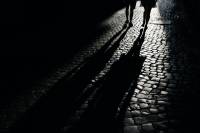Vigils In The Dark

What is a vigil?
A vigil is the term often used by paranormal researchers for a stay in an allegedly haunted place to look for ghosts or other anomalous phenomena. Some researchers use other terms for this, just to clear up any confusion.
The term is used, in ASSAP at least, to describe the whole event. A vigil is generally broken up into 'watches', when teams of researchers stay in particular areas of the building (particularly 'hot spots') watching and waiting for things to happen. After each watch there is a break and then all the teams swap locations so that everyone gets a turn in each position.
Vigils in the dark
Many groups do vigils in the dark, ie. with the lights turned off. But is there any justification for this?
Ghosts have been reported at all times of day in a variety of levels of illumination. Crucially, however, unlike in Hollywood films apparitions do not glow (with the possible exception of 'radiant boys'). Most witnesses report ghosts as looking and behaving like normal people. It is possible that a ghost could walk right through the middle of a 'lights out' vigil without anyone even noticing it!
There are other problems with putting the lights out for vigils. For instance, people's eyes take time (around 20 minutes) to get used to the dark before they can see much. This means that 20 minutes out of each watch is useless. Even once eyes are dark-adapted, they can only see poorly (particularly missing detail) because human eyes don't work well in low light. In addition, sitting around in the dark raises levels of suggestibility. This will make it more likely to mistake ambiguous stimuli for paranormal phenomena. People can end up 'experiencing' non-existent phenomena that were not even reported by the original witnesses. Thus, such vigils may generate new reports of phenomena which are entirely spurious. For more on night vision problems, such as autokinesis and the night blind spot,
Since most haunting phenomena are generally experienced by original witnesses in perfectly normal lighting, holding vigils in the dark is an artificial experience. It does not duplicate the original conditions of the reported experiences. It may therefore stand less chance of reproducing the originally reported phenomena, rather than more.
There are, of course, also health and safety concerns with dark vigils. Quite simply, it is easier to have an accident if you're walking around in the dark!
People experiences are different
People will report different things on vigils when they are in the same room at the same time! This effect is not confined to dark vigils but the additional ambiguity introduced by losing visual cues hardly helps. Sight is the most powerful sense in forming impressions and without it, other factors, like the group dynamic, can predominate.
r full witness reports have been thoroughly examined and the location extensively researched. ASSAP also sometimes holds one-off vigils in places with a long-held reputation for being haunted for specific research.
Research questions
Sometimes vigils are held to answer specific research questions. For instance, the team might look for magnetic fields anomalies in 'hot spots' (see left). Such research vigils are generally more valuable than the general variety. There are often too many variables to control on a general vigil. Research vigils can concentrate on a few specific variables.
The first vigil of a new case will generally be a general one. It will be designed to see if the originally reported phenomena can be witnessed by other people.
However, later vigils at the same location should be aimed at more specific questions like 'what is special about this hot spot where most things have been reported?'
Why vigils at night?
We do vigils at night for purely practical reasons. It is nothing to do with ghosts only coming out at night! There are reports of apparitions from throughout the day.
Quite simply, night is usually the only practical time to have full control of a building, when no one else is using it. You need to be able to control where everyone is (and where they aren't!) so that you can be sure who or what is responsible for any noises (or other possible phenomena). Only by accounting for the normal can we hope to find the paranormal.
In addition, at night there is usually less noise so that it is possible to hear faint sounds.
Hot spots
Haunted places aren't haunted equally all over. There are usually particular rooms in a haunted house where things have been witnessed repeatedly while other areas have produced nothing. Such a 'hot spot' might even be just part of a room. Clearly, this implies that there is something different about such hot spots compared to their surrounding areas. Research into hot spots is probably the most important area in haunting research today.